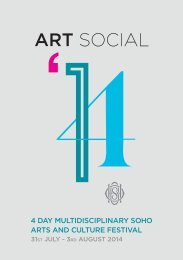The House of St Barnabas' Culture V1
This book was created by The House of St Barnabas and our friends at agency B+A to share the story of our culture as it stands today. It includes stories from the many people who contribute towards our purpose; supporting London's homeless back to employment.
This book was created by The House of St Barnabas and our friends at agency B+A to share the story of our culture as it stands today. It includes stories from the many people who contribute towards our purpose; supporting London's homeless back to employment.
Create successful ePaper yourself
Turn your PDF publications into a flip-book with our unique Google optimized e-Paper software.
A HISTORY OF THE HOUSE IN TEN DATES<br />
1679 Cadogan Thomas held a lease for a “great corner house”<br />
on Soho Square.<br />
1746 <strong>The</strong> <strong>House</strong> was partially rebuilt. <strong>The</strong> stable yard is now<br />
the site <strong>of</strong> the chapel.<br />
1754 <strong>The</strong> Rococo decorative scheme was first crafted.<br />
1811 1 Greek <strong>St</strong>reet is no longer a private <strong>House</strong>.<br />
1846 Dr Henry Monro & Roundel Palmer founded a <strong>House</strong><br />
<strong>of</strong> Charity to provide individuals with help.<br />
1859 Dickens’ ‘A Tale <strong>of</strong> Two Cities’ was published and<br />
immortalised the garden in which Dr Manette & Lucy<br />
were portrayed entertaining.<br />
1862 <strong>The</strong> charity purchased 1 Greek <strong>St</strong>reet. <strong>The</strong> Chancellor <strong>of</strong><br />
the Exchequer at the time spoke <strong>of</strong> the <strong>House</strong> as “the only<br />
home <strong>of</strong> refuge for the waifs and strays <strong>of</strong> the turbid sea<br />
<strong>of</strong> human society.”<br />
1864 <strong>The</strong> first services took place in the new Chapel <strong>of</strong><br />
<strong>St</strong> Barnabas, the saint whose name was later adopted<br />
for the <strong>House</strong>.<br />
1957—1958 In WWII the Chapel was bombed. <strong>The</strong> restoration included<br />
fine stained glass by John Hayward.<br />
2005 Trustees decided it was no longer feasible to operate the<br />
<strong>House</strong> as a hostel and embarked on an exciting new journey<br />
to turn the <strong>House</strong> into a social enterprise.<br />
START 11




